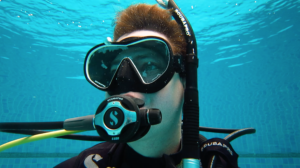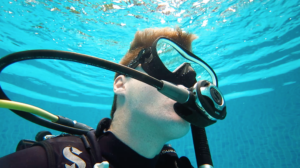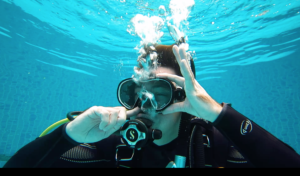Many people struggle to equalize their ears when they dive. They erroneously think they have an ear problem and many stop diving before even giving it an honest try. But much of the time we can attribute this failure to equalize to using the wrong techniques or improper execution of what they have learned. Here we’ll share four easy techniques and tips on the best ways to equalize your ears.
Is it really an ear problem?
People often say they have a problem with their ears and are not sure they can dive. While some people do have a medical issue with their ears or sinuses, that’s not true most of the time. So why do so many people struggle when equalizing their ears?
In most cases, it’s because someone has, for example, experienced ear problems in an airplane or when they went swimming. Especially on an airplane, people feel the pressure change on their ears as discomfort or pain. In most cases, however, it’s because of an ear problem, but rather that they just haven’t properly learned how to equalize.
Why must we equalize when scuba diving?
As soon as your head dips below the surface, water will flow into your ears. This puts pressure on your eardrums. For most people this isn’t painful in the first few feet, but if you don’t equalize your ears, the pressure keeps building from discomfort even to pain. To solve this problem, we must equalize our ears by adding air into our sinuses and Eustachian tubes to counter the water pressure.
The Valsalva maneuver
The first tip to successfully equalize your ears is to use the Valsalva maneuver. This is by far the easiest and most common technique for scuba diving. To do this correctly, pinch your nose with your fingers and then gently blow air into your sinuses. This works because with your nose pinched closed and your mouth on your regulator, the air has nowhere else to go but through your Eustachian tubes and your eardrums. You must not blow too hard or you can damage your ear.
If this doesn’t work on the first try, ascend a little bit and try again. If that still doesn’t work, try the second-best equalizing technique: swallowing.
Swallowing can help

Candy or gum help when you fly because chewing on them makes you swallow, which in most cases will equalize your ears. Some people even prefer to swallowing over the Valsalva maneuver to equalize their ears while scuba diving.
Wiggle your jaw

The third tip is to wiggle or move your jaw from side to side. This stretches the Eustachian tubes, which can equalize your ears.
You can also try to move your head from side to side or even attempt all equalizing techniques at the same time or any combination you find helpful.
The last tip is a bit uncommon: blow your nose underwater.
Why does blowing your nose help?

May people have sinus congestion, which can block the Eustachian tubes. This makes it impossible to blow air into the eardrum. By blowing your nose underwater you remove that congestion, allowing any of the equalizing techniques described above to work well.
To do it, keep your mask on your face and gently but steadily blow your nose, one nostril at the time. This will create some congestion in your mask. Just clear it by exhaling through your nose and then afterward pinching your nose to do the Valsalva maneuver.
Combined with some patience, equalizing techniques should work for most people, even those who think their ears are keeping them from enjoying the underwater world.
Guest author Marcel van den Berg is a PADI Platinum Course Director at Sairee Cottage Diving in Koh Tao, Thailand. Subscribe to their YouTube channel here.

